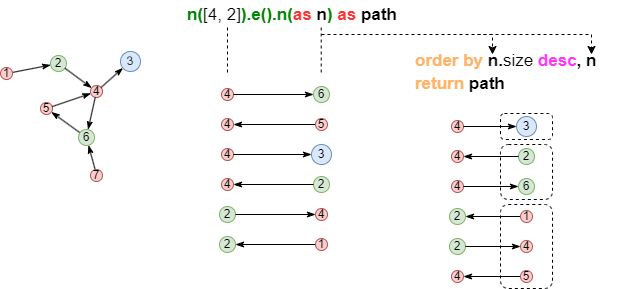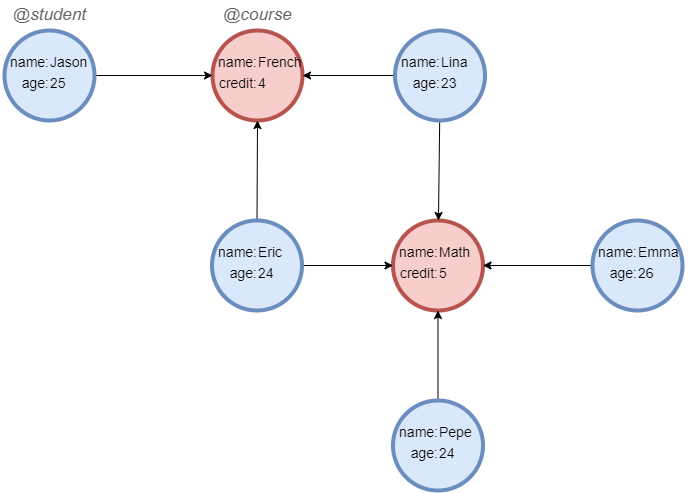ORDER BY ajuste l'ordre des lignes dans l'alias.
Syntaxe : ORDER BY <expression> <string>, <expression> <string>, ...
Entrée :
: Critère de tri ; plusieurs critères doivent être homologues et sont opérés de gauche à droite : Mode de tri, soit ASC ou DESC (insensible à la casse), ou ASC lorsque omis
Par exemple, ajuste l'ordre des chemins à une étape path, d'abord en fonction du rayon décroissant des nœuds terminaux n, puis par ordre croissant d'ID de n si n partage le même rayon.

n([4, 2]).e().n(as n) as path
order by n.radius desc, n
return path
Exemple de graph : (à utiliser pour les exemples suivants)

create().node_schema("student").node_schema("course")
create().node_property(@*, "name").node_property(@student, "age", int32).node_property(@course, "credit", int32)
insert().into(@student).nodes([{_id:"S001", _uuid:1, name:"Jason", age:25}, {_id:"S002", _uuid:2, name:"Lina", age:23}, {_id:"S003", _uuid:3, name:"Eric", age:24}, {_id:"S004", _uuid:4, name:"Emma", age:26}, {_id:"S005", _uuid:5, name:"Pepe", age:24}])
insert().into(@course).nodes([{_id:"C001", _uuid:6, name:"French", credit:4}, {_id:"C002", _uuid:7, name:"Math", credit:5}])
insert().into(@default).edges([{_uuid:1, _from_uuid:1, _to_uuid:6}, {_uuid:2, _from_uuid:2, _to_uuid:6}, {_uuid:3, _from_uuid:3, _to_uuid:6}, {_uuid:4, _from_uuid:2, _to_uuid:7}, {_uuid:5, _from_uuid:3, _to_uuid:7}, {_uuid:6, _from_uuid:4, _to_uuid:7}, {_uuid:7, _from_uuid:5, _to_uuid:7}])
Groupement et Ordre
Exemple : Trouver les chemins à 1 étape @course-@student, grouper par course et calculer le nombre d'étudiants dans chaque groupe, et trier les résultats dans le comptage décroissant
n({@course} as a).e().n({@student})
group by a
with count(a) as b
order by b desc
return table(a.name, b)
| a.name | b |
|--------|---|
| Math | 4 |
| French | 3 |
Ordre Multi-niveaux
Exemple : Trouver les chemins à 1 étape @course-@student, trier les résultats par ordre croissant de credit de course, puis par ordre décroissant de age de student
n({@course} as a).e().n({@student} as b) as p
order by a.credit, b.age desc
return p{*}
French <---- Jason
French <---- Eric
French <---- Lina
Math <---- Emma
Math <---- Eric
Math <---- Pepe
Math <---- Lina

